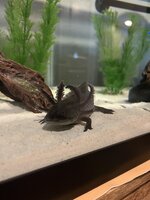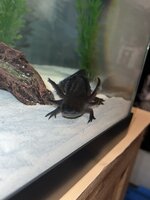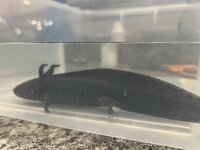proberge
Member
Hey Everyone,
I am looking for some advice or assistance since there are no vets around my area that can help. About two weeks ago I noticed one morning that my axolotl had thrown up her worms she ate the night before and I thought it just could have been me over feeding but I tried again the next day with bloodworms and the same thing happened I found them thrown up the next morning. After that she is now refusing any food and has not eaten for around 2 weeks. When I try to give her food she just violently shakes her head when I put the food in front of her face. She is also hiding a bunch more and won’t come out of her hide for anything which isn’t like her she was normally very active and always would greet you at the front of the tank. I have also been noticing her gills are not as fluffy as before and are getting thin and last night I notice green poop which I have not seen before. My parameters are perfect no ammonia, no nitrite and I keep the nitrate under 20-40ppm the water is also kept at 64F with a chiller so there isn’t any fluctuation. I did a water change last night but still don’t see any improvements. I have bought some Repashy grub pie and also garlic guard to hopefully have her eat.
I am looking for some advice or assistance since there are no vets around my area that can help. About two weeks ago I noticed one morning that my axolotl had thrown up her worms she ate the night before and I thought it just could have been me over feeding but I tried again the next day with bloodworms and the same thing happened I found them thrown up the next morning. After that she is now refusing any food and has not eaten for around 2 weeks. When I try to give her food she just violently shakes her head when I put the food in front of her face. She is also hiding a bunch more and won’t come out of her hide for anything which isn’t like her she was normally very active and always would greet you at the front of the tank. I have also been noticing her gills are not as fluffy as before and are getting thin and last night I notice green poop which I have not seen before. My parameters are perfect no ammonia, no nitrite and I keep the nitrate under 20-40ppm the water is also kept at 64F with a chiller so there isn’t any fluctuation. I did a water change last night but still don’t see any improvements. I have bought some Repashy grub pie and also garlic guard to hopefully have her eat.













